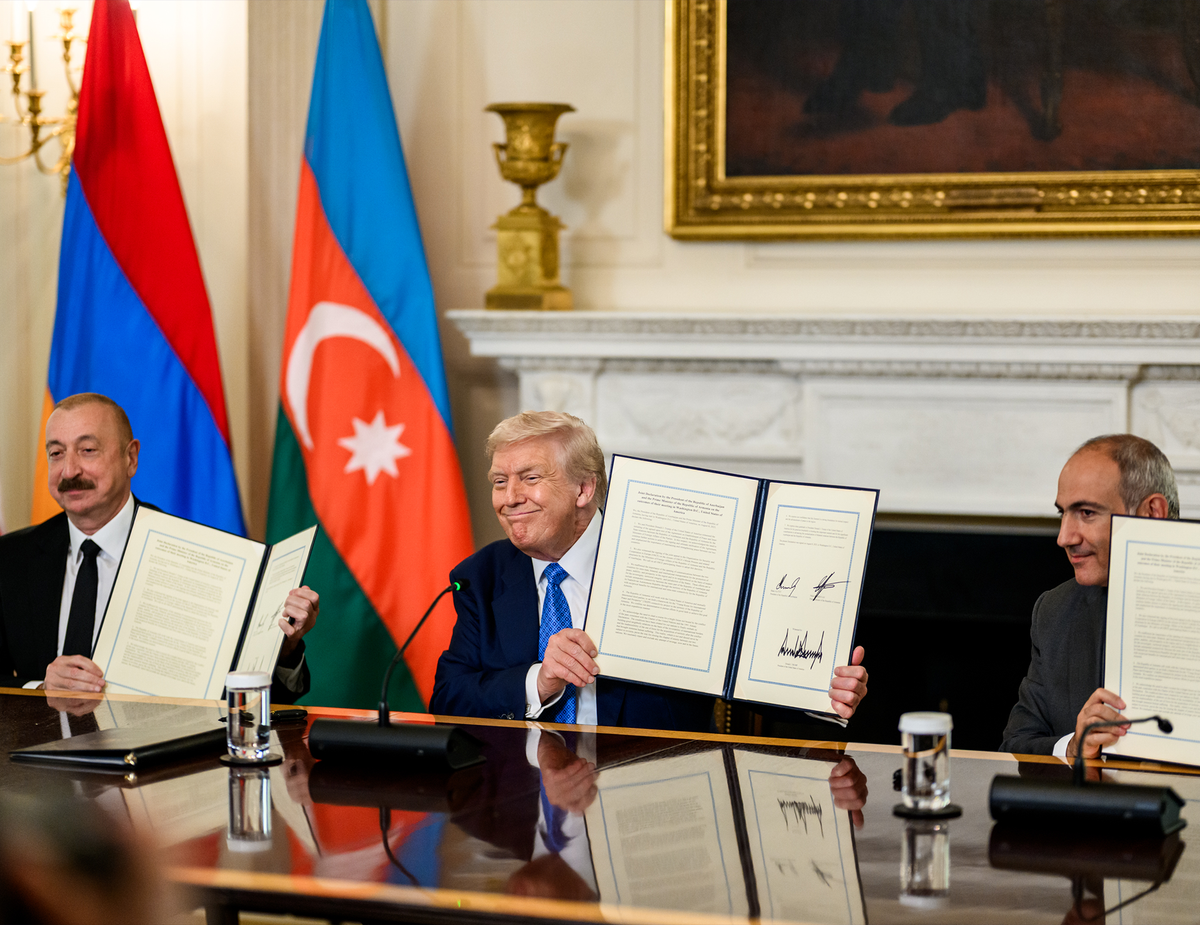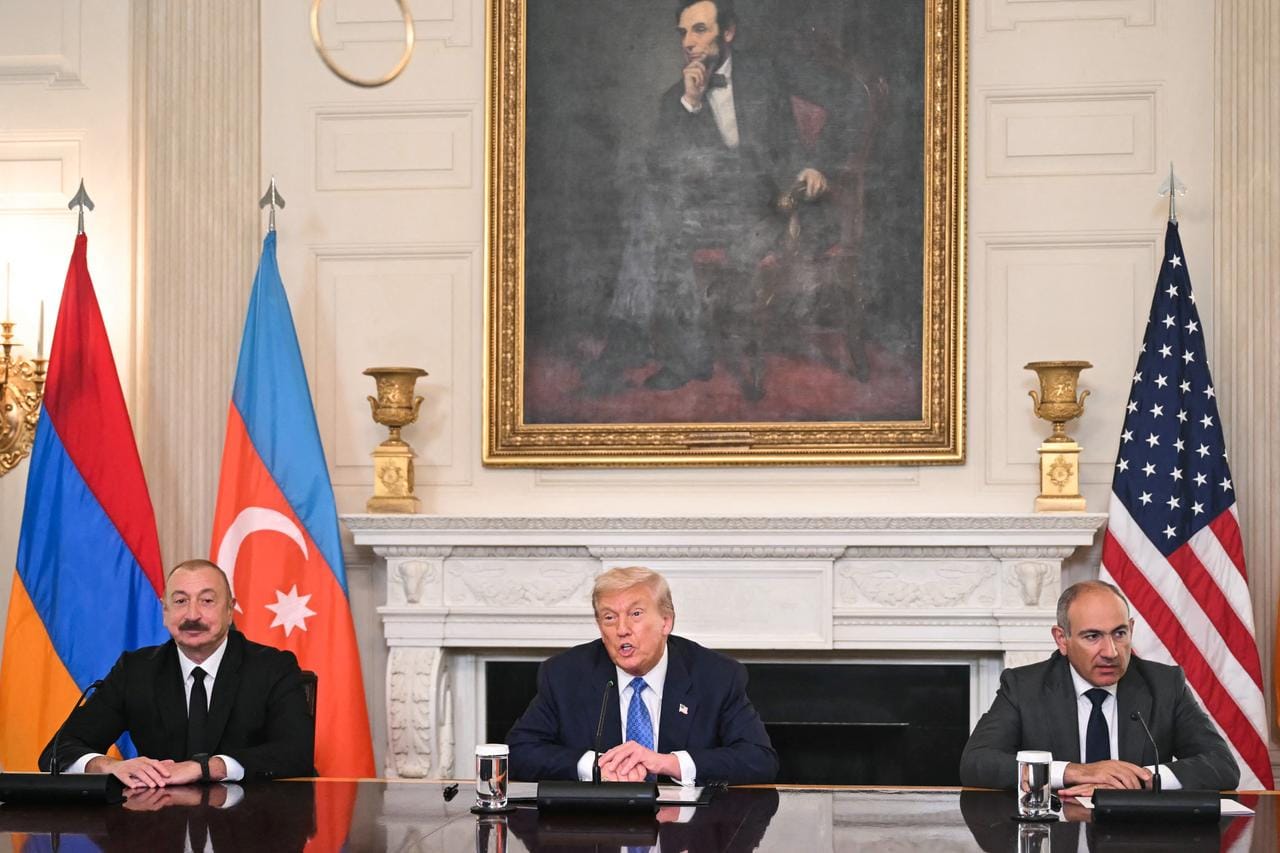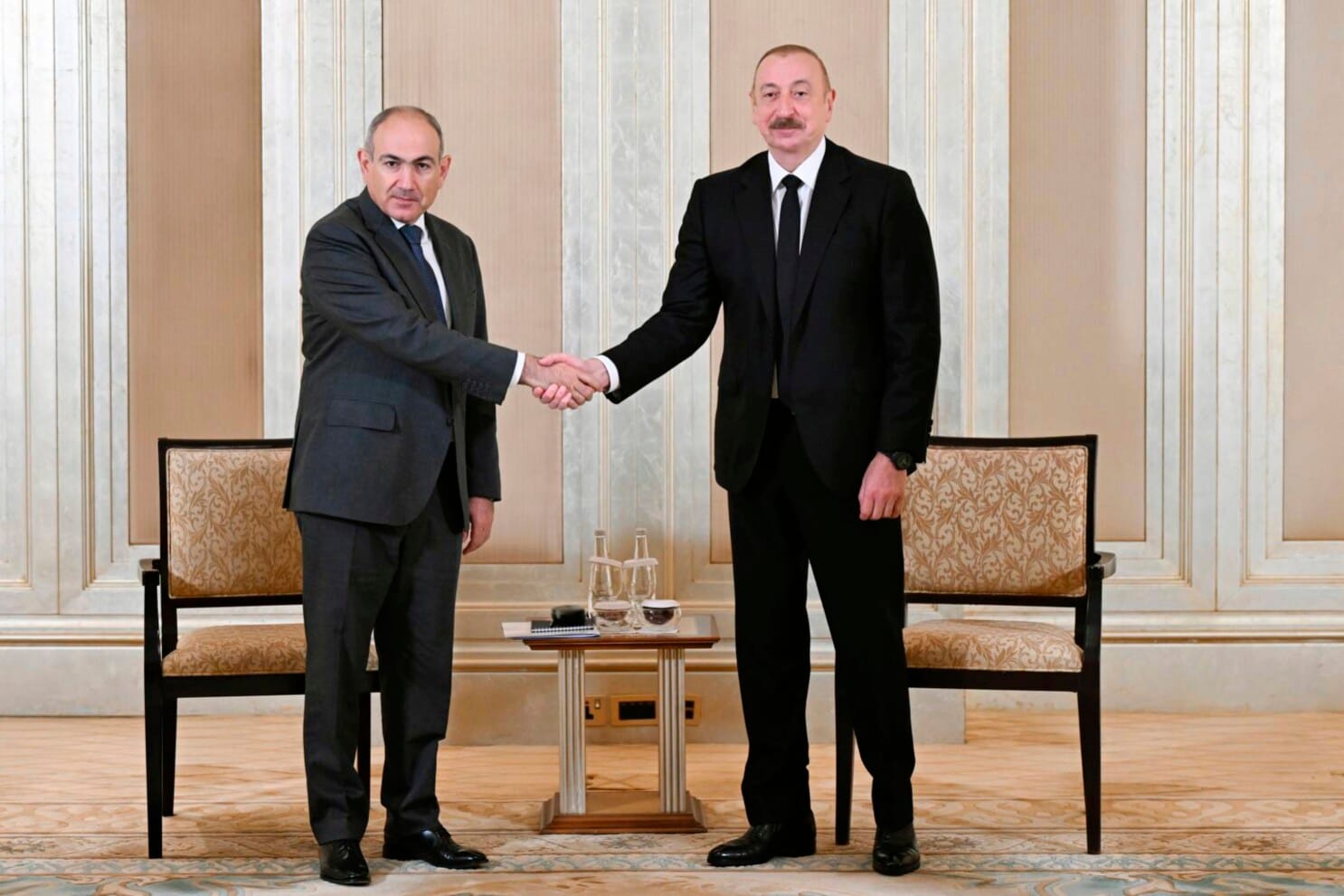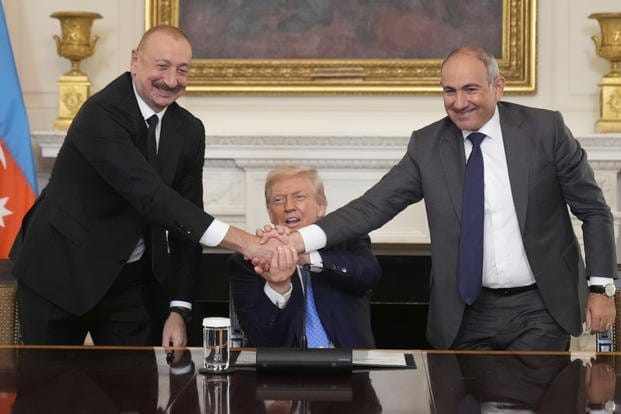Historic Peace at the White House: A New Era for Armenia, Azerbaijan, and the South Caucasus
In a monumental diplomatic breakthrough, Armenia and Azerbaijan signed a U.S.-brokered peace agreement at the White House, ending decades of conflict. The deal, which includes a major transit corridor, is set to reshape regional geopolitics, commerce, and connectivity.

Written by Lavanya, Intern, Allegedly The News
WASHINGTON, August 12, 2025
A Historic Turning Point: The Armenia-Azerbaijan Peace Accord
The echoes of a 37-year-long conflict, marked by two devastating wars and immeasurable human suffering, may finally be fading. In a landmark ceremony at the White House, the leaders of Armenia and Azerbaijan signed a peace agreement, a diplomatic feat brokered by the United States that many believed was impossible. This historic accord is not merely a ceasefire; it is a comprehensive framework designed to end decades of hostility and fundamentally reshape the geopolitical landscape of the South Caucasus. The deal, which includes the creation of a major new transit corridor, is being hailed as a "miracle" by some and a strategic gambit by others. This report will delve into the intricate details of the agreement, its potential to forge a lasting peace, the complex web of regional and global interests at play, and the formidable obstacles that lie ahead.
The peace agreement, a culmination of months of intense U.S.-led diplomacy, marks a decisive shift away from the traditional diplomatic channels that have, for decades, failed to resolve the conflict. With Russia's influence waning due to its protracted war in Ukraine, the White House stepped into the vacuum, offering a powerful economic incentive to secure a lasting settlement. President Donald Trump, presiding over the signing, emphasized the significance of the moment, declaring, "Thirty-five years they fought, and now they're friends and they're going to be friends a long time." The core of the deal is a new transit corridor, a strategic artery that promises to unlock immense economic potential but also raises serious questions about regional sovereignty and the balance of power.
The Nagorno-Karabakh conflict, which began in 1988, has been a defining feature of the South Caucasus for generations. It was born from the ashes of the Soviet Union, as ethnic tensions over the Armenian-populated enclave of Nagorno-Karabakh, located within the internationally recognized borders of Azerbaijan, boiled over. The first war from 1988 to 1994 resulted in an estimated 30,000 deaths and left Armenian forces in control of Nagorno-Karabakh and surrounding territories. Subsequent mediation efforts, largely led by the Russian-dominated OSCE Minsk Group, proved ineffective. In 2020, Azerbaijan, backed by its ally Turkey, launched a six-week war that reclaimed significant territory. The final chapter of the conflict saw Azerbaijan's swift military action in September 2023, which led to the full reintegration of Nagorno-Karabakh and the mass exodus of over 100,000 ethnic Armenians. This outcome created a new reality on the ground, paving the way for the recent negotiations.

The Framework of Peace: Deconstructing the Historic Agreement
The peace accord signed in Washington is a multi-faceted document that addresses the core issues of the conflict while laying the groundwork for future cooperation. At the heart of the deal is the "Trump Route for International Peace and Prosperity" (TRIPP), a transit corridor that will connect mainland Azerbaijan to its Nakhchivan exclave through a narrow strip of Armenian territory. This route, previously a major sticking point in negotiations, is now a cornerstone of the peace process.
Key Terms and Provisions
- Sovereignty and Territorial Integrity: The agreement's preamble and core clauses mandate that both Armenia and Azerbaijan recognize and respect each other's sovereignty and territorial integrity within their internationally recognized borders. This is a critical point for Azerbaijan, which has long asserted its claim over Nagorno-Karabakh, and for Armenia, which has expressed concerns about the corridor's impact on its sovereignty. The deal explicitly states that the corridor will operate under Armenian law, a safeguard intended to address Yerevan's fears.
- The Trump Route (TRIPP): The corridor itself is a marvel of geopolitical engineering. It is designed to include railways, highways, energy pipelines, and fiber-optic cables. The U.S. has secured exclusive 99-year development rights to the corridor, which will be subleased to a consortium of American companies. This provision not only offers a powerful economic incentive but also firmly plants a U.S. presence in the region, a strategic move that fundamentally challenges Russian and Iranian influence.
- Dissolution of the OSCE Minsk Group: The agreement includes a joint letter to the Organization for Security and Co-operation in Europe (OSCE) requesting the dissolution of the Minsk Group. This body, co-chaired by Russia, the U.S., and France, was the main mediation channel for decades but had become largely obsolete. Its dismantling is a clear signal that the two countries and the U.S. are moving beyond the old, Russia-centric diplomatic framework.
- Economic and Diplomatic Normalization: In addition to the joint peace agreement, Armenia and Azerbaijan have signed separate bilateral agreements with the U.S. to enhance cooperation in energy, technology, and economic development. These deals are designed to create a web of interdependence that will make a return to conflict economically costly for both sides.

The Strategic Lifeline: The Transit Corridor's Geopolitical Implications
The TRIPP is far more than a simple transportation route; it is a new geopolitical artery that could redraw the map of Eurasian trade. For Azerbaijan, the corridor provides a direct and unimpeded link to its exclave of Nakhchivan and, critically, to its strategic ally, Turkey. This link strengthens the Turkic world's connectivity, offering Azerbaijan a more secure and efficient route for its oil and gas exports to Europe that bypasses both Russia and Iran.
For Armenia, the corridor represents a seismic shift. As a landlocked nation that has long been isolated from major regional trade routes, the TRIPP offers the potential for significant economic revitalization. Armenia stands to benefit from transit fees and increased commerce, positioning itself as a central hub in a new East-West corridor. The deal's success hinges on a delicate balance: securing these economic benefits while preserving national sovereignty.
This project's strategic value for Europe, Asia, and the Middle East cannot be overstated. It creates a new "Middle Corridor" for trade that is independent of Russian and Iranian influence. For the European Union, which is seeking to diversify its energy sources and trade routes, the TRIPP offers a more direct link to the Caspian Sea and Central Asia. For global commerce, it creates a new artery for goods and services to travel between continents, effectively reviving a modern-day Silk Road.
The Diplomatic Masterstroke: A Closer Look at the White House's Role
The path to this historic signing was fraught with challenges, but the decisive factor was the White House's direct and robust diplomatic engagement. The U.S. recognized a unique window of opportunity created by Russia’s distraction in Ukraine and the recent power shift on the ground. A key element of the U.S. strategy was the use of "economic statecraft", where the promise of significant American investment and development rights was used as leverage to bring the two nations to the negotiating table.
President Trump and his envoy, Steve Witkoff, engaged in shuttle diplomacy, meeting with leaders in Baku and Yerevan to iron out the details. The deal's naming as the "Trump Route" is a clear reflection of the U.S.'s pivotal role and the personal investment of the President in the peace process. This diplomatic success serves a dual purpose for the U.S.: it not only resolves a long-standing conflict but also strategically positions Washington as a key partner in the South Caucasus, displacing Russia's traditional role and establishing a foothold in a region of critical geopolitical importance.
The U.S.'s influence on the negotiations was not merely as a mediator but as a dealmaker with tangible, high-value incentives. By offering development rights and a consortium of American companies to build and manage the corridor, the White House created a powerful economic argument for peace that was difficult for either side to refuse.
Navigating a Fragile Peace: Obstacles and Risks
Despite the celebratory signing, the path to a lasting peace is fraught with potential obstacles. The deep-seated mistrust between Armenia and Azerbaijan, a legacy of decades of conflict and recent military actions, remains a significant challenge. The deal does not fully resolve the humanitarian crisis, as it does not explicitly outline a path for the return of the ethnic Armenian population that fled Nagorno-Karabakh in 2023.
Moreover, the reactions of key regional players pose a major risk to the deal's stability.
- Russia: Sidelined from the mediation process, Russia has issued cautious statements while warning against "non-regional players" creating new divisions. Moscow's diminished influence is a major consequence of this deal, and Russia may seek ways to undermine its implementation to reassert its authority.
- Iran: Tehran has expressed strong opposition to the TRIPP, fearing it will sever its border with Armenia and allow for a foreign presence along its northern flank. Top Iranian officials have warned that they will not allow the corridor to proceed, framing the project as a threat to national security.
- Turkey: As a strong backer of Azerbaijan, Turkey has fully embraced the deal. The corridor is a strategic boon for Ankara, strengthening its ties to the broader Turkic world and enhancing its role as a key player in Eurasian transport.
- The European Union: The EU has welcomed the deal, seeing it as a positive step toward regional stability and a new pathway for trade that aligns with its own interests in bypassing Russia.

A New Chapter for the South Caucasus
The peace agreement signed by Armenia and Azerbaijan is a monumental step forward, offering a tangible path to ending one of the world's most enduring conflicts. By leveraging its diplomatic and economic power, the White House has not only brokered a peace deal but has also fundamentally redrawn the geopolitical map of the South Caucasus. The TRIPP is a powerful engine for change, promising to boost commerce, connectivity, and infrastructure, which could transform the region from a zone of conflict into a hub of international trade. However, the success of this fragile peace will ultimately depend on the political will of both nations to overcome their historical grievances and the ability of the U.S. to manage the competing interests of regional powers. The road ahead is long and uncertain, but for the first time in decades, the promise of a peaceful and prosperous South Caucasus seems within reach.
New Question for Discussion
How can Armenia and Azerbaijan build domestic support for an agreement that, for one side, is seen as a victory and for the other, as a painful concession? What mechanisms can be put in place to foster genuine reconciliation and trust among their populations?
Sources
The Associated Press, Times of India, Wikipedia, Official Press Service of the Government of Armenia, Patrick Semansky / Associated Press / AP news, Brendan Smialowski / AFP via Getty Images, Official White House Photo by Tia Dufour, The Guardian, Al Jazeera, Carnegie Endowment for International Peace.




